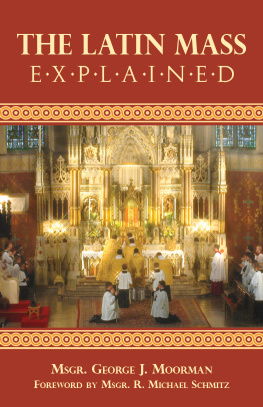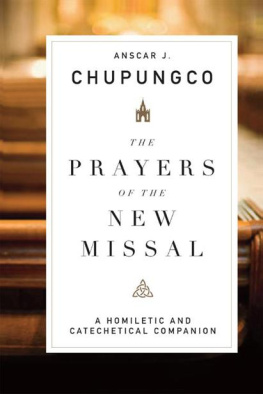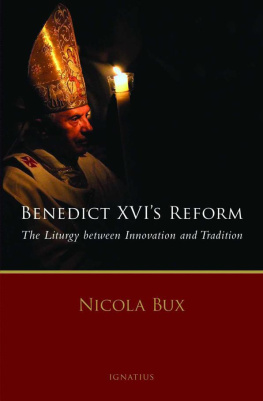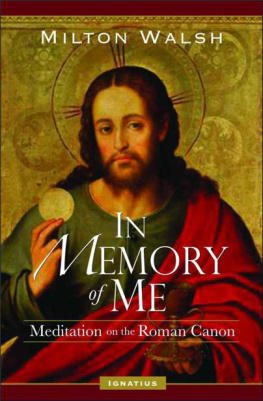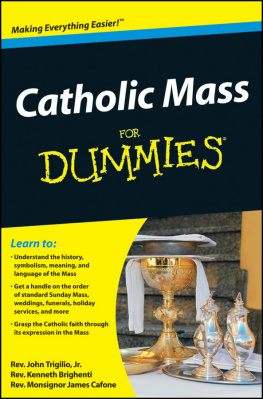The Voice of the Church at Prayer
Uwe Michael Lang
The Voice of the Church
at Prayer
Reflections on Liturgy and Language
IGNATIUS PRESS SAN FRANCISCO
Cover art:
Saint Peter , from an illuminated manuscript
Fra Angelico (1387-1455)
Nicolo Orsi Battaglini / Art Resource, New York
Cover design by Roxanne Mei Lum
2012 by Ignatius Press, San Francisco
All rights reserved
ISBN 978-1-58617-720-1
Library of Congress Control Number 2011940930
Printed in the United States of America
CONTENTS
ABBREVIATIONS
CCCM Corpus Christianorum. Continuatio Mediaevalis. Turnhout: Brepols, 1966.
CCSL Corpus Christianorum. Series Latina. Turnhout: Brepols, 1953.
CSEL Corpus Scriptorum Ecclesiasticorum Latinorum. Vienna: Geroldi, then Tempksy, 1866.
PG Patrologiae Cursus Completus, accurante J.-P. Migne. Series Graeca. 166 vols. Paris: Petit-Montrouge, 1857-1883.
PL Patrologiae Cursus Completus, accurante J.-P. Migne. Series Latina. 221 vols. Paris: J.-P. Migne, 1844-1865.
SC Sources Chretiennes. Paris: Cerf, 1941.
Missale Romanum 1570
Missale Romanum ex decreto Sacrosancti Concilii Tridentini restitutum Pii V Pont. Max. iussu editum . Rome: Apud heredes Bartholomei Faletti, Joannem Variscum & socios, 1570.
Missale Romanum 1962
Missale Romanum ex decreto SS. Concilii Tridentini restitutum Summorum Pontificum cura recognitum . Editio typica. Vatican City: Typis Polyglottis Vaticanis, 1962.
Missale Romanum 1970
Missale Romanum ex decreto Sacrosancti Oecumenici Concilii Vaticani II instauratum auctoritate Pauli PP. VI promulgatum . Editio typica. Vatican City: Typis Polyglottis Vaticani, 1970.
Missale Romanum 2008
Missale Romanum ex decreto Sacrosancti Oecumenici Concilii Vaticani II instauratum auctoritate Pauli PP. VI promulgatum Ioannis Pauli PP. II cura recognitum . Editio typica tertia, reimpressio emendata. Vatican City: Typis Vaticanis, 2002.
Roman Missal 1974
Roman Missal: Revised by Decree of the Second Vatican Council and Published by Authority of Pope Paul VI . London: Collins Liturgical, 1974.
Roman Missal 2011
Roman Missal: Renewed by Decree of the Most Holy Second Ecumenical Council of the Vatican, Promulgated by Authority of Pope Paul VI and Revised at the Direction of Pope John Paul II . Totowa, N.J.: Catholic Book Publishing, 2011.
INTRODUCTION
This is a propitious time to write a book about liturgy and language. Benedict XVI has placed the sacred liturgy at the heart of his pontificate, and the decisions he has taken in this regard are of lasting significance both on a theoretical and on a practical level. The Pope, noted for his own scholarly contributions on the subject, explains his rationale in Theology of the Liturgy , the eleventh volume of his collected writings, which was the first one to be published, at his express wish, in 2008. In his preface, dated June 29, 2008, the Solemnity of Saints Peter and Paul, Benedict XVI observes that this choice was an obvious one to him, because the liturgy has been central to his life ever since his childhood and it is the heart of his theological work. However, there is another reason to begin the series with the volume on the liturgy: the editorial project aspires to reflect the order of priorities of the Second Vatican Council. The Holy Father draws attention to the fact that the Councils first document was the Constitution on the Sacred Liturgy, Sacrosanctum concilium . In his view, this was not just a pragmatic decision that seemed expedient in the given circumstances; rather, it reflects the right ordering of the Churchs life and mission:
By beginning with the theme of liturgy, the primacy of God, the priority of the theme God, was unequivocally brought to light. God first: this is meant by beginning with the liturgy. When the focus is not on God, everything else loses its orientation. The words of the Benedictine rule.... Let nothing be put before the Work of God (43, 3) apply specifically to monasticism, but as an order of priority, they are also true for the life of the Church and of each and every one... in his own way.
Pope Benedict then recalls a theme he has explored in his various writings on the liturgy, the fullness of the meaning of orthodoxy:
It is perhaps useful to recall that in the term orthodoxy, the second half of the word, doxa , does not mean opinion, but glory ( Herrlichkeit ): this is not a matter of a correct opinion about God, but of a proper way of glorifying him, of responding to him. For this is the fundamental question of the man who begins to understand himself in the correct way: How should I encounter God? Thus, learning the right way of adorationof orthodoxyis the first gift the faith bestows upon us.
In his homilies and discourses, and in a special way in his own liturgical celebrations, Benedict XVI has consistently followed this order of priorities and has conveyed to a worldwide public his profound theological concern, which he has expressed in his many writings on the subject, namely, that the sacred liturgy must be a reflection of the glory of God. This holds true especially for the celebration of Holy Mass, where the Paschal Mystery of Christs Passion, death, and Resurrection is made present ever anew in sacramental form.
Liturgy mattersnot only because, from a purely empirical perspective, it is at Sunday Mass that the vast majority of practicing Catholics experience the Church. More profoundly, the worship of God is the summit toward which the activity of the Church is directed; at the same time it is the font from which all her power flows,
Language is obviously an essential aspect of the liturgy, but there are more specific reasons why this subject is pertinent in the present time. In the first place, there is a renewed interest in Latin, which has been the liturgical language of the Christian West ever since late antiquity. The Fathers of the Second Vatican Council granted a significant extension of the use of the vernacular in the Catholic liturgy, which had been used to a very limited extent before, with the primary motive of promoting the fully conscious and active participation of the people in the sacred rites. However, they did not envisage a general and total replacement of Latin as the liturgical language of the Catholic Church with the mother tongue.
Even today, the Latin language holds primacy of place as the liturgical language of the Roman rite, although most celebrations are in fact held in the vernacular.
The strongest impulse for a renaissance of Latin as a liturgical language was given with the Motu Proprio Summorum Pontificum of July 7, 2007, which lifted previous restrictions that applied to the Missale Romanum of 1962 and the other liturgical books in use before 1970. They now constitute the Extraordinary Form, or usus antiquior (older use), which, together with the Ordinary Form, is an expression of the one Roman rite. Obviously, the liturgical language contributes much to the sacred and stable character of the usus antiquior , and hence the Popes statement should also be considered a call for the recovery of Latin in the Ordinary Form.
There is a second reason why historical and theological reflections on liturgy and language are topical: the question of translation. In the wake of the Second Vatican Council, the new liturgical books were translated into the many vernaculars of the world. The instruction Liturgiam authenticam , issued by the Congregation for Divine Worship and the Discipline of the Sacraments in 2001, marked the beginning of a thoroughgoing assessment and revision of these translations. This process is of particular consequence in the English-speaking world, for reasons that will be addressed in this study, and it has already yielded what is perhaps its most important fruit, the new Roman Missal , which has been implemented in most Anglophone countries in the course of the year 2011.
Next page
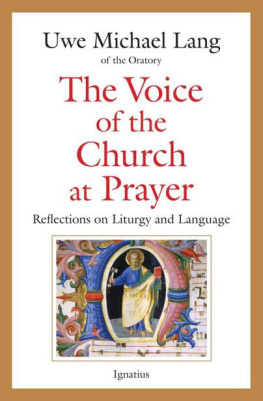


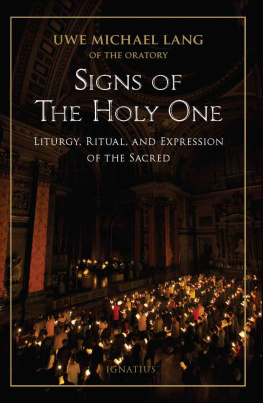
![Pope John XXIII - The Roman Missal [1962]](/uploads/posts/book/272720/thumbs/pope-john-xxiii-the-roman-missal-1962.jpg)
